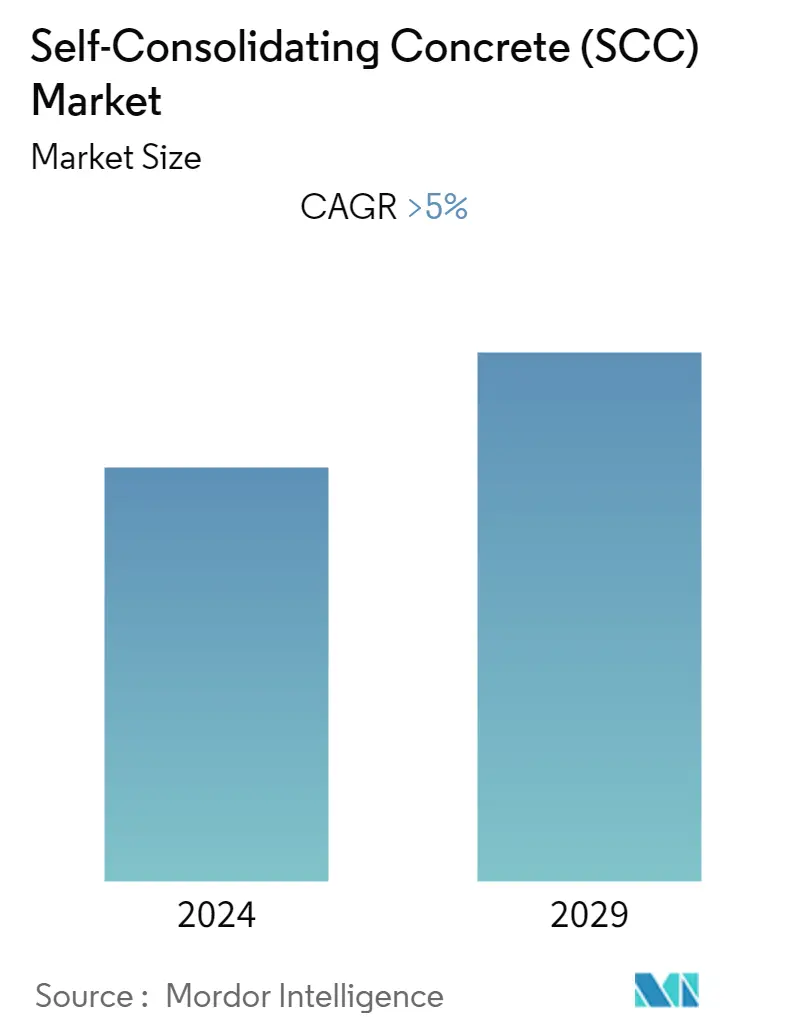Market Size of Self-Consolidating Concrete (SCC) Industry

| Study Period | 2019 - 2029 |
| Base Year For Estimation | 2023 |
| Forecast Data Period | 2024 - 2029 |
| CAGR | 5.00 % |
| Fastest Growing Market | Asia Pacific |
| Largest Market | Europe |
Major Players_Market_-_Key_Players.webp)
*Disclaimer: Major Players sorted in no particular order |
Self-Consolidating Concrete (SCC) Market Analysis
The global self-consolidating concrete (SCC) market is expected to grow with a CAGR greater than 5% during the forecast period. One of the major factors driving the market is the superior durability and reduced environmental footprint.
- Non-requirement of the vibration process for SCC is another major driver for the market studied.
- Among the applications, the precast concrete application is likely to account for the highest market share during the forecast period.
- Asia-Pacific is expected to account for the highest growth rate during the forecast period.
Self-Consolidating Concrete (SCC) Industry Segmentation
The self-consolidating concrete (SCC) market report includes:
| Constituent | |
| Cement | |
| Aggregates | |
| Admixtures | |
| Other Constituents |
| Application | |
| Precast Concrete | |
| Architectural | |
| Residential | |
| Infrastructure | |
| Other Applications |
| Geography | ||||||||
| ||||||||
| ||||||||
| ||||||||
| ||||||||
|
Self-Consolidating Concrete (SCC) Market Size Summary
The self-consolidating concrete (SCC) market is poised for significant growth, driven by its superior durability and reduced environmental impact. The non-requirement of vibration processes further enhances its appeal, making it a preferred choice in various construction applications. The precast concrete segment is anticipated to dominate the market, given its extensive use in products like flooring units, architectural cladding, and structural components. These products are integral to the longevity of structures and can be recycled for further use, reinforcing the sustainability aspect of SCC. The Asia-Pacific region is projected to experience the highest growth rate, reflecting the increasing adoption of SCC in construction activities.
Europe currently leads the SCC market, with Germany, the United Kingdom, and France being the primary contributors to its demand. The region's focus on low-noise construction and the recovery of its construction and housing sector are key factors supporting market expansion. Additionally, the rising popularity of Smart Dynamic Concrete (SDC) is bolstering market growth in Europe. The global SCC market is moderately consolidated, with major players like BASF SE, SIKA AG, CEMEX S.A.B. de C.V., Breedon Group plc, and LafargeHolcim holding significant market shares. These companies are instrumental in driving innovation and meeting the growing demand for SCC solutions.
Self-Consolidating Concrete (SCC) Market Size - Table of Contents
-
1. MARKET DYNAMICS
-
1.1 Drivers
-
1.1.1 Superior Durability and Reduced Environmental Footprint
-
1.1.2 Non-requirement of Vibration Process
-
-
1.2 Restraints
-
1.2.1 Impact of COVID-19 Pandemic
-
1.2.2 Other Restraints
-
-
1.3 Industry Value-chain Analysis
-
1.4 Porter's Five Forces Analysis
-
1.4.1 Bargaining Power of Suppliers
-
1.4.2 Bargaining Power of Consumers
-
1.4.3 Threat of New Entrants
-
1.4.4 Threat of Substitute Products and Services
-
1.4.5 Degree of Competition
-
-
-
2. MARKET SEGMENTATION
-
2.1 Constituent
-
2.1.1 Cement
-
2.1.2 Aggregates
-
2.1.3 Admixtures
-
2.1.4 Other Constituents
-
-
2.2 Application
-
2.2.1 Precast Concrete
-
2.2.2 Architectural
-
2.2.3 Residential
-
2.2.4 Infrastructure
-
2.2.5 Other Applications
-
-
2.3 Geography
-
2.3.1 Asia-Pacific
-
2.3.1.1 China
-
2.3.1.2 India
-
2.3.1.3 Japan
-
2.3.1.4 South Korea
-
2.3.1.5 ASEAN Countries
-
2.3.1.6 Rest of Asia-Pacific
-
-
2.3.2 North America
-
2.3.2.1 United States
-
2.3.2.2 Canada
-
2.3.2.3 Mexico
-
-
2.3.3 Europe
-
2.3.3.1 Germany
-
2.3.3.2 United Kingdom
-
2.3.3.3 Italy
-
2.3.3.4 France
-
2.3.3.5 Rest of Europe
-
-
2.3.4 South America
-
2.3.4.1 Brazil
-
2.3.4.2 Argentina
-
2.3.4.3 Rest of South America
-
-
2.3.5 Middle-East and Africa
-
2.3.5.1 Saudi Arabia
-
2.3.5.2 South Africa
-
2.3.5.3 Rest of Middle-East and Africa
-
-
-
Self-Consolidating Concrete (SCC) Market Size FAQs
What is the current Self-Consolidating Concrete (SCC) Market size?
The Self-Consolidating Concrete (SCC) Market is projected to register a CAGR of greater than 5% during the forecast period (2024-2029)
Who are the key players in Self-Consolidating Concrete (SCC) Market?
BASF SE, SIKA AG, CEMEX S.A.B. DE C.V., Breedon Group plc and LafargeHolcim are the major companies operating in the Self-Consolidating Concrete (SCC) Market.

